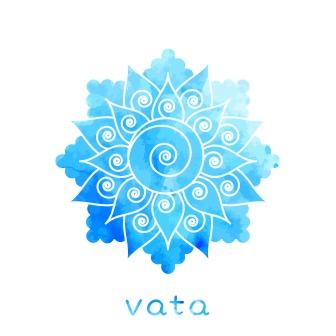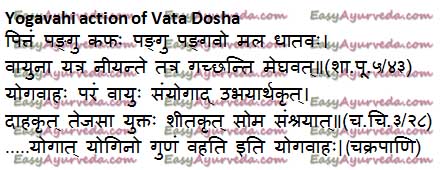Yogavahi: How Vata Dosha Interacts With Pitta And Kapha
Article by Dr Raghuram Y.S. MD (Ay)
All the functions of the body are monitored and governed by 3 doshas, Vata, pitta and Kapha. This concept contributes to the whole of Ayurveda physiology (kriya shaareera). The same concept contributes to the Ayurveda Pathology. When these doshas are in a ‘state of balance’ (equilibrium), they help in maintenance of health. But on the other hand, if one or more of the doshas are disturbed, they tend to contaminate the body tissues and cause their damage, leading to the onset of disease process and manifestation of diseases.
Again among the 3 doshas, Vata or Vayu is the prime one.
A famous quotation from Sharangadhara Samhita explains in brief the authority of Vayu in the body. He tells ‘Pitta, Kapha, the Dhatus (tissues), Malas (excreta, metabolic wastes), everything in the body is lame. They cannot move by themselves anywhere unless motivated, provoked, carried, pushed or pulled by Vata. Just like the clouds move from one place to other being carried by the winds, the other elements of the body too move from one place to the other in the body only when carried by Vayu’. Thus all activities are contributed to Vata.

This exposes another interesting property of Vata, its Yogavahitwa.
Read related: Ayurveda Vata Diet – What To Take And What To Avoid For Vata
Table of Contents
Yogavahi property
Yogavahi Property of Vayu
Vata can carry a normal or abnormal (vitiated, morbid) pitta or a normal or abnormal (vitiated, morbid) kapha.
If vata carries normal pitta to another site, it carries all the qualities of pitta like sneha (unctuousness), teekshna (intense and deep penetrating property), ushna (heat), laghu (lightness) visram (typical odour), saram (flow), dravam (liquidity). This will happen when pitta is needed at another place to carry on its activities (metabolism etc). Similarly, Vata can also carry an abnormal pitta to another site, the pitta which has been vitiated. When vata carries such pitta to another site, the morbid pitta damages the tissues or organs to which it has been carried to by vata and causes various diseases. Thus, Vata is responsible for both normal and abnormal activities of pitta.
Similar is the case when Vata carries Kapha. If vata carries normal kapha to another site, it carries all the qualities of kapha like snigdha (unctuousness), sheeta (coldness), guru (heaviness), manda (slow acting), shlakshna (smooth), mrutsna (soft), sthira (stability), pichchila (sticky, slimy) etc. This will happen when kapha is needed at another place to carry on its activities (metabolism etc). Similarly, Vata can also carry an abnormal kapha to another site, the kapha which has been vitiated. When vata carries such kapha to another site, the morbid kapha damages the tissues or organs to which it has been carried to by vata and causes various diseases. Thus, Vata is responsible for both normal and abnormal activities of kapha.
Different Causes For Vata Dosha Imbalance, Increase
Sanskrit verse

How is this possible?
This happens due to a special property of Vayu known as Yogavahi guna. Yogavahitwa is a capacity to carry some other thing to a distant place (of need) and making it available at the place of its utilisation. This is like a vehicle which carries us to our destiny. Vata, similarly transports pitta, kapha, tissues to different places (where they are needed) in the body and also help in flushing out the metabolic wastes and excreta out of the body.
Vayu or Vata is Yogavahi in nature. Vata behaves like Pitta and acquires daaha, ushnata etc pitta gunas (qualities of pitta) on association with pitta. The same Vata on association with kapha, acquires sheetadi gunas and behaves like kapha. In spite of being sheeta and having properties of itself, Vayu takes the form of whichever dosha it carries in circulation and produces a similar impact (ushnata or sheetata) wherever it goes.
Here, Vayu creates the impact of dosha it is carrying and doesn’t manifest itself.
Yogavahi is that which carries the qualities of that thing or substance with which it is associated in the combination. Since Vata carries the qualities of Pitta and Kapha, it is called Yogavahi (said to possess Yogavahi property). Vata creates an impact of the dosha it carries to the target tissue or organ, but doesn’t manifest itself too much.
Other variants of ‘Vata acting like a Yogavahi’
Vata can push and pull things and elements in the body and displace them or transport them from one place to the other. These can cause good (constructive) effects as well as bad (destructive or damaging) effects.
While being Yogavahi, Vata can either be normal or vitiated one. It can displace and transport normal or abnormal doshas, toxins, metabolic wastes and or tissues in the body.
Dosha prasara
Prasara of Doshas – The transit of morbid doshas from one place of the body to the other is due to Yogavahi nature of Vata. If the doshas undergoing prasara (pathological outflow, encroachment of morbid doshas into other territories), gets lodged in weak tissues, tissue damage takes place (sthana samshraya) and diseases will get manifested (vyakti bhava).
Koshta gati
Koshta gati – The doshas have to come to the koshta (gut, visceral organs) to render their functions. This movement happens from shakha (tissues) to the koshta (doshas are seated in shakha or dhatus). This is mandatory for all the activities to take place. This movement is facilitated by Vayu, its Yogavahi guna. This is a physiological process and takes place on daily basis.
Shaka gati
Shakha Gati – This is opposite of Koshta Gati. This is the movement of doshas from koshta to shakha, but not the other way. In this the doshas get stagnated or localized in the tissues and damage them. This is a pathological process leading to wide array of diseases. This condition is treated by controlling Vayu. Shakha gati of doshas too take place due to the Yogavahi nature of Vayu.
Ashayapakarsha
Ashayapakarsha – This is a condition in which vitiated Vata pulls or pushes pitta or kapha from their normal sites. In these conditions, Vata will be morbid and pitta and or kapha are innocent (non-vitiated). This is also a variant of Yogavahi nature of Vata.
Just before finish –
Vata is the master of the ‘body orchestra’. It is the guide and transport in charge of all elements in our body, including our thoughts and emotions. Yogavahitwa is a natural phenomenon of Vata. In normal conditions, it helps in managing normal functions of body and mind. When disturbed, it causes various diseases and damages by displacing pitta, kapha and other elements of the body. Thus a good health can be described as ‘a disciplined master’ or ‘a decent and undisturbed vata’.
Click to Consult Dr Raghuram Y.S. MD (Ayu)











6 comments
Sathi
It is a very well written article bringing the beauty and majesty of Vata Dosha as the leader of all doshas. Human physiology is as complex as the structure of body itself with millions of controlling factors operating at the same time. Only Tridoshas with its innate intelligence can do this “job”. Human physiology as taught in modern medicine has no grasp of these phenomena and equally superficial is the Pathology in modern medicine. Please keep up your work and educate and enlighten the people about the complex and fascinating beauty of human body and the way they can keep it healthy and happy.
Is it possible for little more explanation of Koshta and Dhatu and the inter exchanges between them? Once again thank you for your efforts.
Sathi Singh PhD
Dr J V Hebbar MD(Ayu)Author
Thanks for your kind words of appreciation.
An article about Koshta and Dhatu is coming up shortly.
Basically, Kosta refers to Gastro intestinal tract and Dhatu – are the different body tissues – such as blood, muscle, fat, bone, marrow etc.
Mohit
I second above comments. It is a wonderful article, explaining very well about role if vata and its interactions with putta and kapha.
Following this, can we say that shakha gati is the cause of back pain and sciatica like diseases. Thats why treating vata, or like cleansing colon is an important part of its treatment.
It will be very helpful to understand the internals, if you can share more knowledge about vata, its movement and interactions in vack pain kind of diseases.
Thank you
Dr J V Hebbar MD(Ayu)Author
Hi, thanks for your kind words of encouragement.
Hope these articles will be of some use to you –
https://www.easyayurveda.com/2014/02/12/low-back-pain-ayurveda-view-point-treatment/
https://www.easyayurveda.com/2016/01/06/ayurvedic-therapies-for-low-back-ache/
https://www.easyayurveda.com/2010/05/05/back-pain-relief-tips-how-to-strengthen-lower-back/
https://www.easyayurveda.com/2016/01/01/dashamula-kashayam-with-castor-oil-for-low-back-pain/
https://www.easyayurveda.com/2015/12/05/kati-basti-treatment-for-low-back-pain/
Mohit
Thanks for the Wonderful article.
Is Shakha gati the primary cause for lower back pain sort of diseases, and is that the reason that colon cleansing is highly recommended in such condition. What are the other measures to regulate this gati, and what is the cause.
Dr Reshma.M.A
i very much appreciate your efforts in writing these articles,they are precise and very informative.